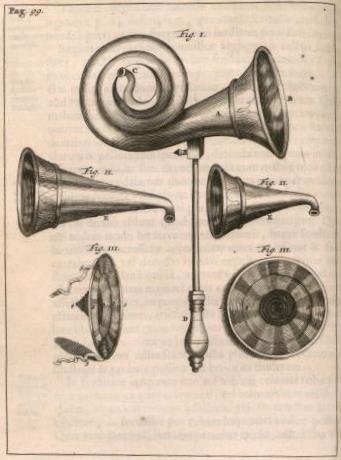
We might take it as a given that our hearing aids are barely detectable, can be managed with our smartphones, and can distinguish between speech and background sound. What we might not realize, however, is that those features are the products of 400 years of experimentation, design, and improvement.
Even 5 years ago, hearing aids could not yield the clarity of sound produced today. To see why, let’s trace the history of hearing aids—beginning today and traveling in reverse—to see how hearing aids would have handled your hearing loss in four different years: 2016, 1985, 1940, and 1650.
2016 – Modern Digital Hearing Aids
It’s 2016 and you’re searching to address your hearing loss. You open up an internet browser, search for a nearby hearing care professional, complete a brief form, and book a consultation.
At your hearing exam, your hearing is screened using sophisticated computer technology that precisely assesses your hearing. Then, with the help of your hearing expert, you pick out a hearing aid that suits your needs from a wide selection of models.
Then, your hearing professional programs your new hearing aids to enhance only the sounds and frequencies you have trouble hearing, which results in crystal clear sound without distortion.
If you told anyone in the 1980’s that this would be the process, they wouldn’t have thought it was possible.
So what did render it possible? In short, digital technology.
For most of their history, there was no way for hearing aids to differentiate between assorted sound frequencies. Hearing aids would amplify all inbound sound, including background noise, generating distorted sound.
The digital revolution addressed that challenge. With digital technology, all information can be altered, saved, and manipulated as combinations of 0’s and 1’s. Digital technology permitted hearing aids to convert sound frequencies into digital information, which could then be classified in accordance with which sounds should be amplified (speech) and which should be suppressed (background noise).
The first all-digital hearing aid was created in 1995, and since then the technology has improved significantly, eventually to incorporate wireless capability.
1985 – Transistor Hearing Aids
Now it’s 1985 and you’re seeking to treat your hearing loss. You can forget about browsing for a local hearing care provider on the web because the first commercial internet service provider won’t be founded until 1989.
You would need to use the phone book, rely on referrals, or drive around the neighborhood to find a hearing care practice.
After booking a consultation and having your hearing screened, your options for hearing aids are very restricted. With no microprocessor and digital technology, hearing aids were designed with a sequence of transistors. This adds size and increased power requirements, leading to bigger batteries and massive hearing aids.
Also, without the advantage of digital technology, the hearing aid cannot differentiate between different frequencies of sound. Hearing aids receive inbound sound and the transistors function as basic amplifiers, amplifying all sound. So if you’re in a loud room, speech recognition will be just about impossible.
1940 – Vacuum Tube Hearing Aids
It’s 1940 and you’re thinking about buying a hearing aid. Transistors haven’t been applied to hearing aids yet, so your choices are limited to vacuum tube hearing aids.
Vacuum tubes consume more power than transistors, so the hearing aids require larger batteries, making the hearing aids big, heavy, and cumbersome.
And once again, without digital technology, the hearing aids can only act as straightforward amplification devices, making all incoming sound louder. The hearing aids can’t enhance speech and can’t remove background noise.
1650 – Ear Trumpets
Let’s go all the way back to 1650. There’s no digital technology, no transistors, and no vacuum tubes. As a result, there is no way to transform sound into electrical currents that can be amplified.
With electrical amplification unattainable, your only alternative is mechanical amplification by concentrating and compressing sound into the ear canal, as with what takes place when you cup your hands around your ears.
By 1650, gadgets were developed that concentrated inbound sound into the ears, and these contraptions were named ear trumpets. They were prominent devices with a conical end that collected sound and a narrow end that focused the sound into the ear.
This would be the only technology offered to individuals with hearing loss for the next 250 plus years.
Let’s return to 2016. Throughout more than 400 years of history, hearing aids have improved from mechanical amplification devices to electrical amplification devices, from vacuum-tube-based to digital-based. They’ve come to be considerably smaller, lighter, and more effective and affordable.
They’ve also become much better at distinguishing between different types of sound, and in amplifying only selected kinds of sound (such as amplifying speech while suppressing background noise).
Every generation of hearing aid has made a significant improvement over the previous generation. The question is, what’s the next great benchmark in the history of hearing aids?
Will we eventually be able to improve natural human hearing, rather than simply restore it?
